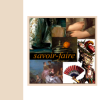Emily Short’s interactive fictional game “Savoir Faire” is a text adventure based on numerous intricate puzzles. The player must solve each puzzle in order to be awarded treasures and clues that lead to a riddle. “Savoir-Faire” begins with a prologue describing an aristocratic young man named Pierre who has returned home to seek financial aid from his family after recently falling into debt. The story takes place in France during the eighteenth century and begins in the deserted house of Pierre’s family. The player controls Pierre as the avatar and dictates the outcome of the game by deciding where to explore. Pierre begins his adventure with a few random objects including a snuffbox and a sword. A dry humour pervades the work: for example, Pierre is described as sporting a ‘dashing hat’ and he often speaks of his graceful dancing skills. Pierre possesses a magical skill, “Lavori d’Aracne,” that allows him to link objects together. This skill proves to be very important throughout the game as it helps to unlock many of the complex puzzles. The player is instructed to type commands that prompt Pierre to look, take, examine and even remember specific aspects of the game. At any time, the player may type ‘help’ in the command bar. Commonly used commands like 'x' and 'y' are listed to help the player begin.
XYZZY awards are given annually to interactive fiction writers. “Savoir-Faire” was nominated for eight awards in 2002 and was awarded four, including ‘Best Game’. Although several versions of the game are now available, each one displays ‘classic’ early amateur entertainment quality. Most of the puzzles are early-generation renditions of locked door puzzles and traditional treasure hunts. Although "Savoir-Faire" is intricate in nature, the captivating story and clever scenarios encourage multiple readings. Though the story begins simply, the plot becomes more complex and develops into an elaborate fantasy.
Emily Short has created a number of challenging interactive fictional games that offer strong narrative. She has written extensively on interactive fictional theory and has demonstrated compelling links between literature and online gaming. Her other interactive fiction works include: Galatea, Metamorphoses, City of Secrets, and Floatpoint.
Tessa Honch was a student of Dr. Kiki Benzon for a course in Contemporary Fiction taught at the University of Lethbridge, Canada during the Winter term of 2011.
